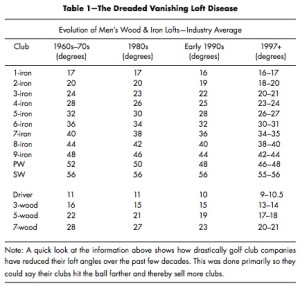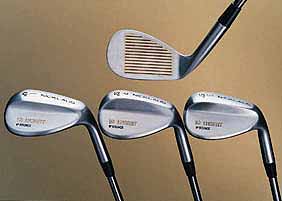The one thing that unites all golfers is their desire to increase the distance between where they tee off and where their ball lands on the fairway or, ideally, the green.
Many factors are at play when a golfer tees off, including the major three factors which determine the distance you hit a golf ball:
- the loft angle of the clubhead
- the speed with which the club impacts the ball
- the angle at which the club meets the ball
However, in recent years golfers have become preoccupied not only with these tried-and-true details, but also with the quality of their golf clubs -more specifically, the newness of their golf clubs. A few hours of watching the Golf Channel or reading a golf magazine can convince even the most seasoned golfer that the problem with their golf game is that they haven’t recently purchased a “longer hitting” set of clubs.
The idea that modern golf clubs can help you hit the ball farther is a myth.
About 30 years ago, golf club manufacturers caught onto the fact that if they labelled their clubs as “hitting farther”, they would be able to not only get veteran golfers to invest in new clubs, but also to expand the amount of clubs available. They did this by altering the clubhead angles, lowering them incrementally over time so that the average golfer -you and I- wouldn’t notice that the loft angle was different from one 5-iron to another. All we would notice was that our new 5-iron hit 10 or 20 yards farther than our old one, not that our 5-iron was actually a 4-iron just a few years ago.
This phenomenon is known as the “vanishing loft disease”, which essentially means that while your swing has stayed the same over the years, the clubs have continued to change. This means that the 7-iron you used five years ago doesn’t add up to the “new” 7-iron you tried at demo day simply because the angle of that club isn’t the same as your old one.
Below is a table which lays out how Vanishing Loft Disease works:

Clubfitting follows the “24/38 Rule”, which states that the average golfer -male or female of any age- can’t consistently hit with an iron that has less than 24-degrees of loft, or more than 38 inches of length. This is because using a club which falls beyond these specifications requires a level of swing precision that most amateur golfers don’t have the time or ability to develop.
This line used to fall on the other side of the 3-iron -so when you bought a set of clubs you could reasonably expect to hit with your 3-iron through pitching wedge. However, as a result of vanishing loft disease, the 24/38 line has moved past the territory of the 5-iron, making the 3-, 4- and even 5-iron unhittable.
So what does this accomplish? In addition to tricking golfers into purchasing new clubs every few years, club manufacturing companies have now put golfers in a position where they’re purchasing 2 to 3 clubs that they can’t even hit, which in turn causes them to spend more money on even more clubs to compensate for the clubs they can’t use.
So the question begs: why spend the extra money on a bunch of clubs you can’t use when you can get custom-fitted clubs instead?

